“Antennas should be heard, not seen”
Photographs included on this page are subject to Copyright ©
After the last few years’ sharp increases in electricity and oil prices, I have decided that my setup must now be simplified.
Gone and sold are my energy-sucking power amplifiers and from July 20, 2024 I only work with the output power that my radio was delivered with = 100 Watt.
With this, the joy is also rediscovered when, just as the angler, you have to fight to get the QSO (the fish) ashore.
The antenna farm will also be reduced to relatively simple wire antennas. No more towers or roofs to climb, my aging body is no longer suited to that kind of thing. In the future my wire antennas will be of a type that can be serviced standing on the ground, with help from telescopic masts and hoists.
Savings on energy will also reduce redundant use of resources and benefit our nature.

The Shack January 2025
The computer are only for rig firmware updates, logging and lookups in QRZ.COM and others.
The computer will never be a part of any radiocommunication wharsoever. It’s my hobby, not my computers.
Soldering iron and screwdriver?
My workbench are upstairs and not worth taking photos of yet.
CW on a PC? Never, I want to have fun.
Shack window view
View over the Baltic Sea (looking towards northeast) from my shack window.
On the flagpoles, left: The Bornholm Island regional flag and right: The Danish flag “Dannebrog”, which celebrates its 800th anniversary June 15, 2019. In the view direction there is more than 300 km to the nearest land.
The photo are from 2019, but the view are still the same, except from new flags on the flagpoles.

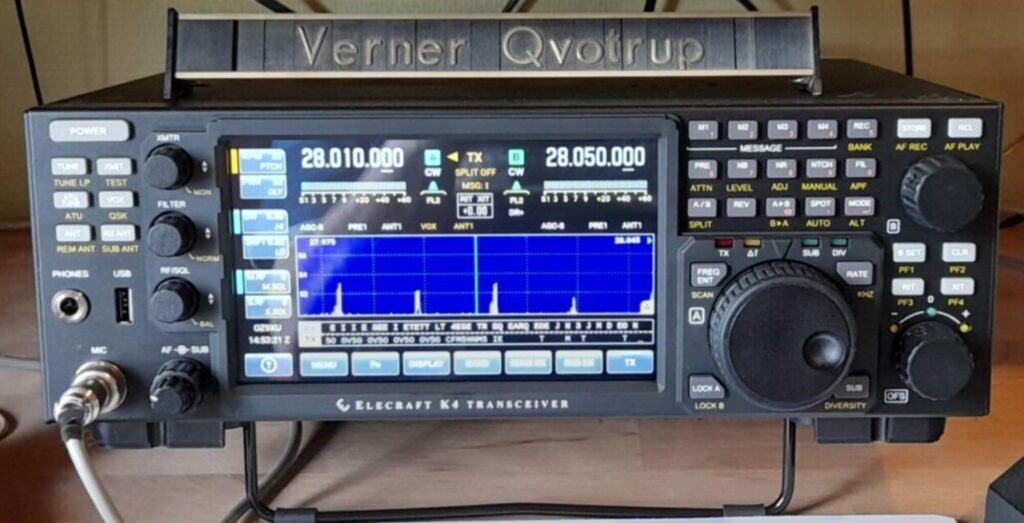
Elecraft K4D Transceiver
Elecraft K4D transceiver with 100 Watt output and internal ATU.
As I mostly work CW, I have not invest in a new microphone, but use the Elecraft MH2 handheld microphone, that was delivered with my old, now spare station, K3 transceiver.
The K4D (and possible KPA500/KPA1500 amplifiers, if available) can be controlled on the PC with the Win4K4Suite application. The application are also available for the K3/K3S, KX2, KX3 and some Icom radios.
Photo: 2023.
Elecraft K3 and P3
Transceiver Elecraft K3 and Panadapter P3 was used 2013 to 2023 as my main station, but now my spare station.
On air now and then for keeping the electronics alive.
Photo: 2020.
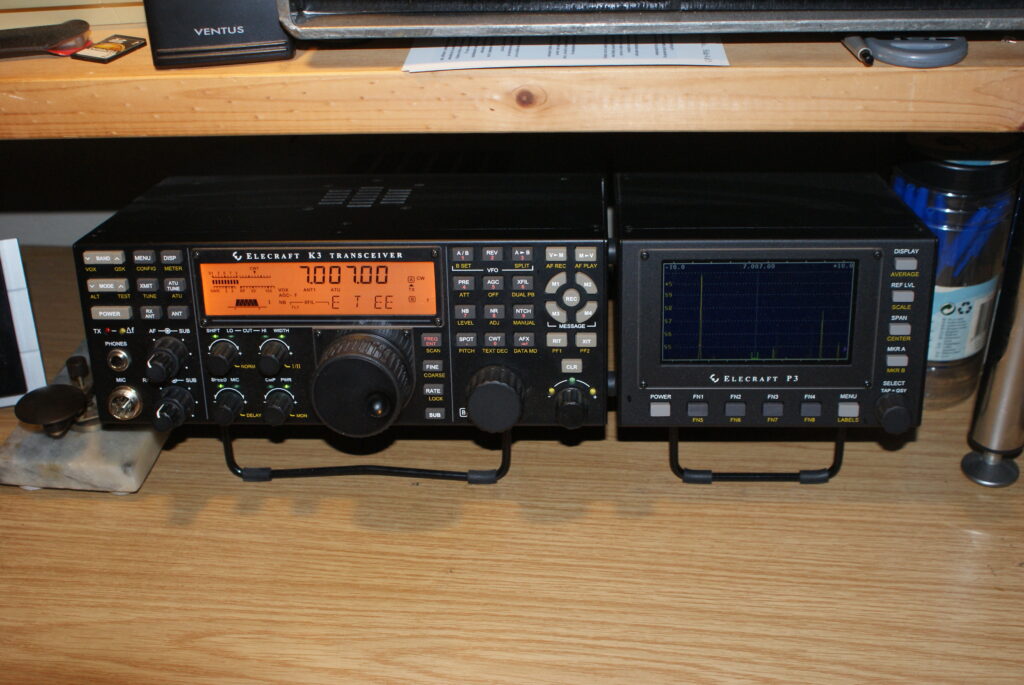

Diamond GSV3000 PSU
Power Supply for Elecraft transceivers.
Up to 15 VDC, but locked at 13.8 VDC.
25 A, peak up to 30 A.
Also output at 10 Amp. and 2 x 6 Amp.
Photo: 2024.
Racal RA17L
Vintage tube communication receiver.
Freq. range: 0.5 through 30 MHz.
Mostly for display, but used from time to time. The receiver has also historic value for me as Racals was used in my professional days as radiooperator.
Photo: About 2016.


Radio Works Carolina Windom CW80
for the 10-80m bands.
The Carolina Windom has replaced my old Fritzel FD-4 OCF-dipole on August 24, 2024 as the FD-4 are sold.
Immediately it works much better than the FD-4, so it’s now my main antenna. I can work on the 6m band, but not the best solution, but I have planned to get my 6m GP antenna up again. Pending for better WX.
The 160m extension (coil and wire) is not installed on this antenna.
So until further notice I have no antenna for 160m.
The main problem are the position of the antenna with the short leg going over the roof of the house and the vertical element are partly shadowed by the house in southwestern, west and northwestern directions.
But I don’t have other possibilities for the setup.
Photo: 2024.
Inverted L for the 60m band.
Made of the 4 lower sections of my MFJ-2990 vertical (abt. 6 meters) with abt. 8 meters of “horizont” wire (the wire are sloping down a bit).
As you can see, just 30 meters from the coast (looking toward northeast), so the antenna are supported with guy ropes due to heavy winds in the fall and winter.
The antenna are cut for the center of the 60m band (5350 kHz), but works good on all portions of the band, sometimes with a little help from my ATU.
It also work great on 40 to 10 meter bands.
The antenna will be replaced with an defective Carolina Windom which have broken wires, but the remaining wires are a little longer than needed for the lenght fit to 60m band. The vertical part (coaxial cable) are also defective.
The balun is still good, so it will be setup as an ordinary OCF-dipole cut for the center of 60m (5350 kHz) when WX permits to working outdoors.
Photo: 2024.


Bengali Graciella Iambic Paddle.
Really very nice finish and it’s heavy, magnetic tension.
My first choice of paddles.
Photo: 2024.
Elecraft Dual Paddle HexKey
Iambic paddle.
Magnetic tension, just a dream! Elecraft, but made by Bencher.
My second choice of paddles.
Photo: 2024.
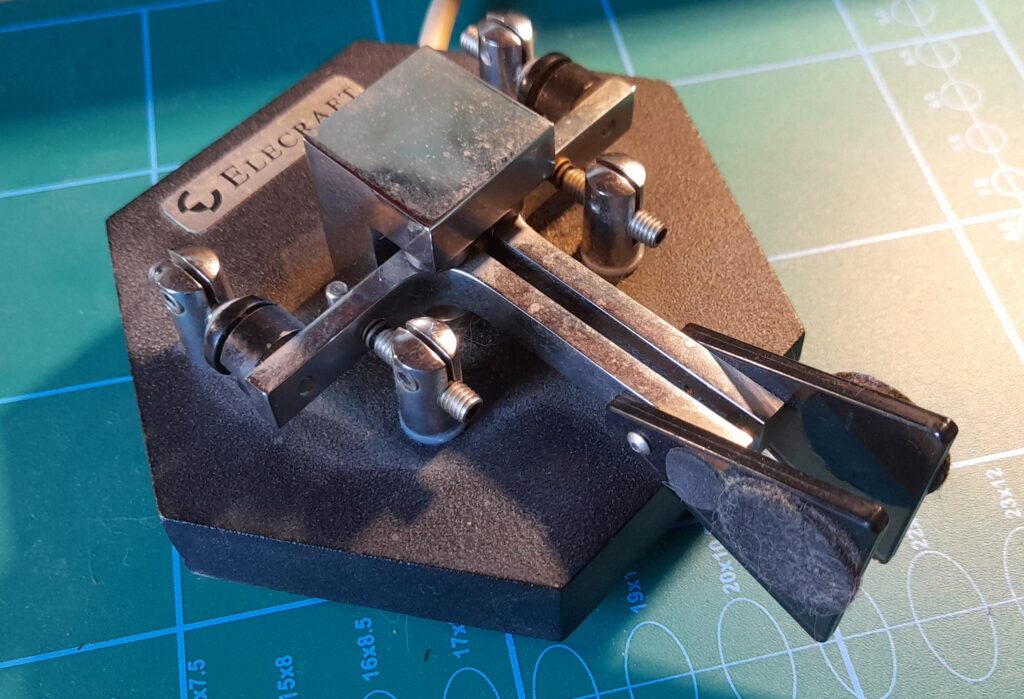

Bencher BY-4 Iambic paddle.
Perfect for my stiff fingers (hi).
Photo: 2024.
Kent Twin TP1-B Iambic paddle.
Very heavy and solid. Nice to use.
Photo: 2024.

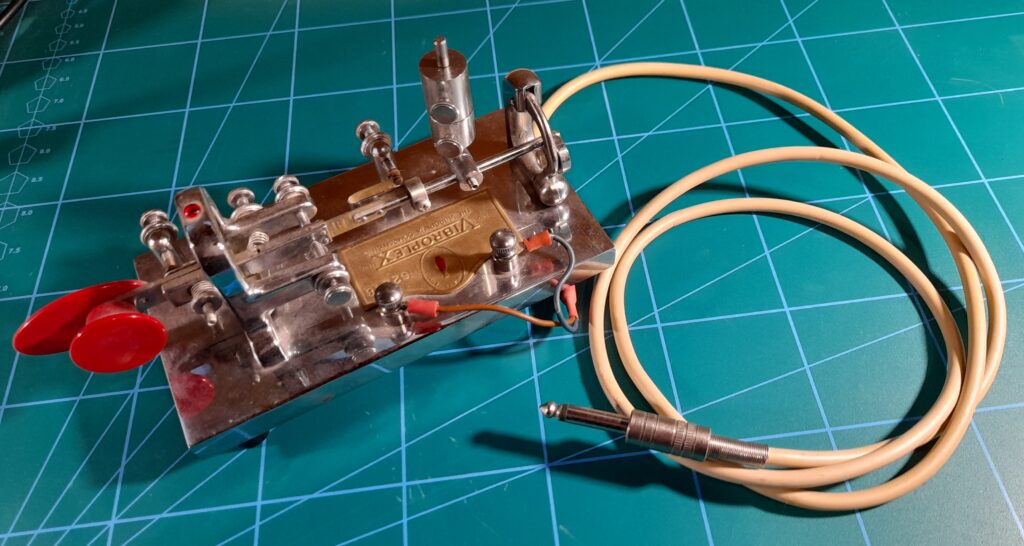
Vibroplex Original de luxe
Unfortunately, it’s too hard for my arthritic fingers and wrists, so the bug are mostly for decoration.
Mounted with the option “Round vario arm” that permits a better and quicker setting of the transmitting speed.
Photo: 2024.
Vibroplex Square Racer Iambic paddle.
Magnetic tension, easy to ajust and use.
Photo: 2024.


CWtouchkeyer P1PAD Iambic paddle.
No moving parts or contacts, you just have to touch the paddles.
You have to pratice a lot, not easy to use. It CAN be very sensitive to HF on some bands, but else nice to use.
Is available in many configurations, with and without internal keyer Electronics. My model have only the paddle Electronics and I use the internal keyer in the transceiver.
Photo: 2024.
Great Northern Telegraph (GNT) handkeys
Two different models.
The black model is similar to the one I – for many years ago – learned the art of CW.
My arthritis wrists and fingers do not allow them to be used daily, but they are touched once in a while.
Photo: 2024.


Elecraft MH2 microphone
Delivered with my Elecraft K3 transceiver in 2013.
As I mostly work CW, the microphone are only used in my daily SSB QSO on 60m band with a handful of other Danish SSB stations.
The microphone is attached to a shelf in front of me and in conjunction with a PTT footswitch or VOX it works excellently as a hands-free microphone.
The microphone type is electret (condenser).
Photo: 2024.
Kotion Each G1200 headset.
With electret (condenser) microphone.
Used in conjunction with a PTT footswitch (or VOX), but rarely used, only if the surroundings are noisy or if my surroundings call for calm 🙂
Photo: 2024.

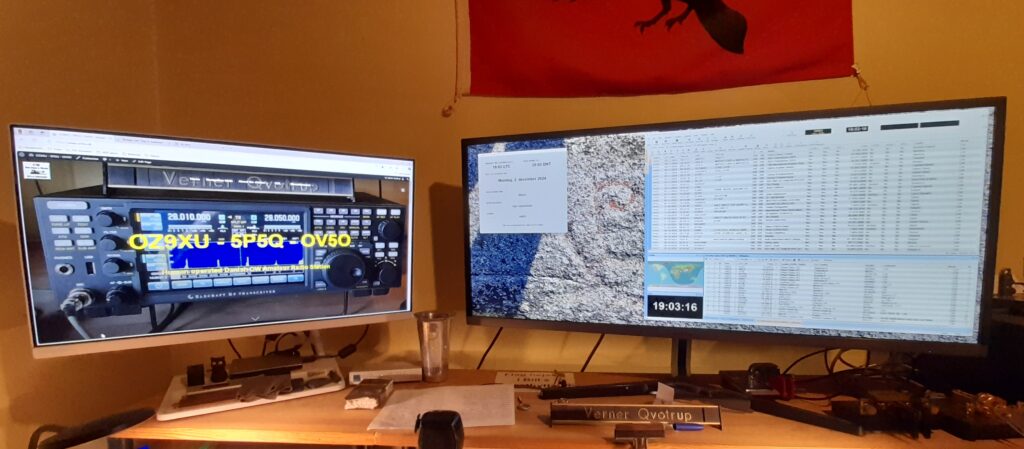
Computer
Lenovo IdeaCentre All-in-one 24″ PC (left).
Samsung Ultra wide monitor 34″ (right).
The computer are only used for rig firmware updates, logging my QSO’s and lookup on the Internet.
The computer will never be a part of any radiocommunication wharsoever. It’s my hobby, not the computers.
Photo: 2024.
My signal strength in the Pacific Ocean with 100 Watt output.
Or was it just a dream? 🙂


Previously used stations.
| Year series | Rig | Status |
|---|---|---|
| 1969 – 1973 | Various radio stations between 25 Watt and 5 kW as professional radio operator. | Still good memories |
| 1971 – 1973 | SM19/SMH (with no TX) as SWL (OZ-DR1651) | Recycled in 1974 |
| 1973 – 1974 | Ten-Tec PM2B QRP transceiver, 2 Watt, modified to 5 Watt output. | Donated in 2013 |
| 1974 – 1977 | Yaesu FT-200 transceiver, 100 Watt output. | Sold in 1977 |
| 1977 – 2011 | Atlas 210x transceiver, 100 Watt output. | Recycled in 2017 |
| 2011 – 2011 | Yaesu FT-101ZD transceiver, 100 Watt output. | Donated in 2013 |
| 2011 – 2013 | Yaesu FT-840 transceiver 100 Watt output. | Sold in 2014 |
| 2017 – 2023 | Yaesu FT-450D, 100 Watt output (ex-Spare station). | Sold in 2024 |
| 2013 – 2023 | Elecraft K3 + P3, 100 Watt output. | Spare station |
| 2019 – 2024 | Elecraft KPA500 Power Amplifier + KAT500 ATU. | Sold in 2024 |
| 2021 – 2024 | Elecraft KPA1500 Power Amplifier/ATU. | Sold in 2024 |
